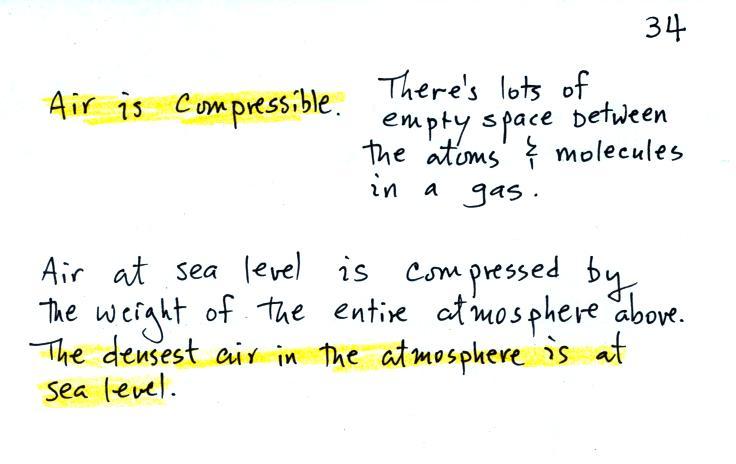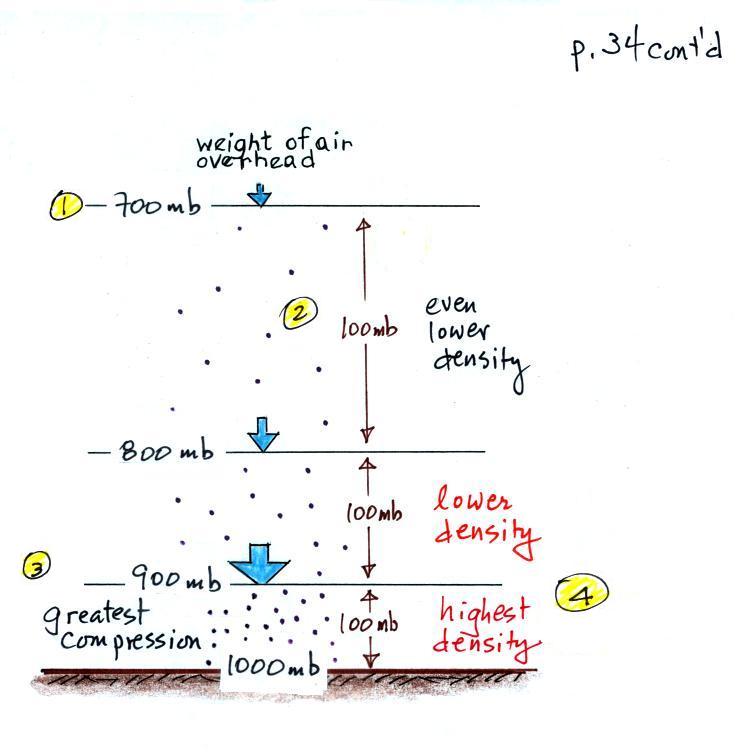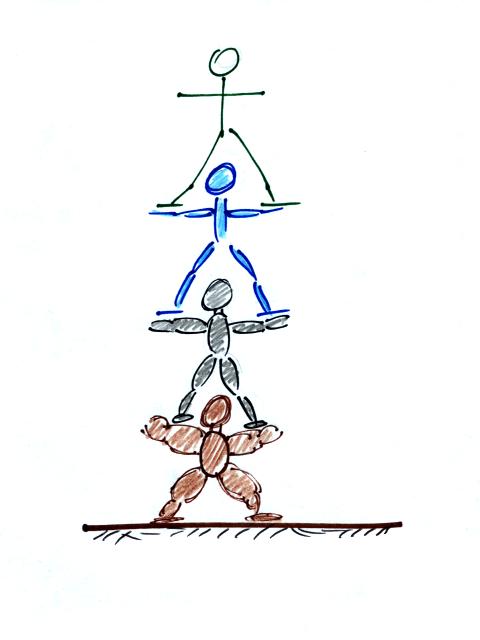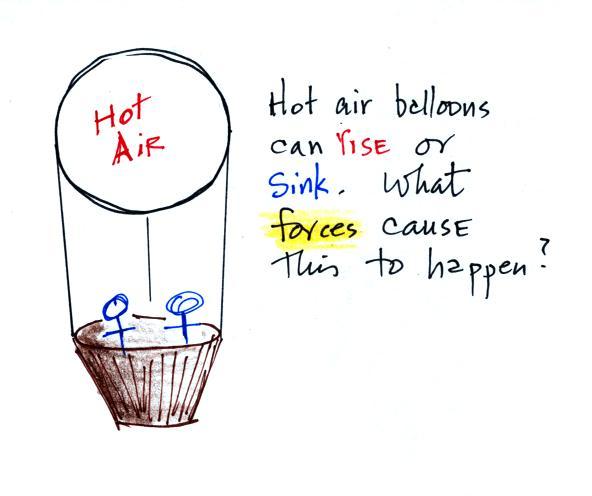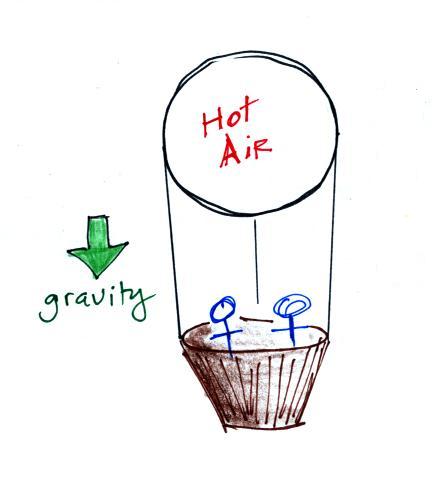Friday, Jan. 27, 2012
click here to
download today's notes in a more printer friendly format
Music from, Calexico, one of my favorite groups. They're a
local group and usually appear somewhere in Tucson at least once a year
(they were on the UA Mall for the January 8 memorial event). They
often appear together with another local group Mariachi Luz de Luna
(I'll play some of their music also at some point during the
semester). Today you heard
Alone Again Or
and Ballad of
Cable Hogue.
On my way back to my office after class on Wednesday I got to wondering
what the pressure was underneath the pile of bricks that I had in class.
It's less than 1 psi. You'd need 94 bricks, 470 pounds of
bricks to produce 14.7 psi.
14.7 psi might not sound like much. But when you start
to multiply 14.7 by all the square inches on your body it turns into
1000s of pounds of weight (force).
A real
potpourri of topics today.
The first topic is a short
explanation of how a mercury barometer
works. A mercury
barometer is used to measure atmospheric pressure and is really
just a balance that can be used to weigh the
atmosphere. You'll find a messier version of what
follows on p. 29 in the
photocopied Class Notes.
 |

|
The instrument in the left figure
above ( a u-shaped
glass
tube filled with a
liquid of some kind) is actually called a manometer and can be used to
measure pressure
difference. The
two ends of the tube are open so that air can get inside and air
pressure can press on the liquid. Given that the liquid levels on
the two sides of the manometer
are equal, what could you about PL
and PR?
The liquid can slosh back and
forth just like the pans on a balance can move up and down. A
manometer really behaves just like a pan balance (pictured above at
right) or a teeter totter (seesaw).
Because
the
two
pans
are
in
balance,
the
two
columns
of
air
have
the
same
weight. PL
and PR
are equal (but note
that you don't really know what either pressure is, just that they are
equal).
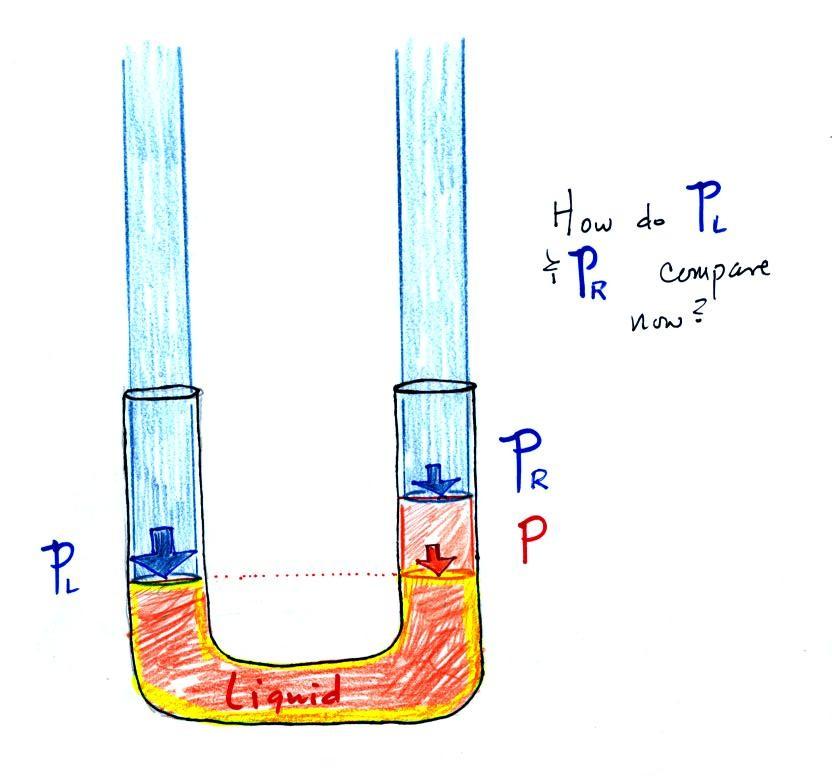 |
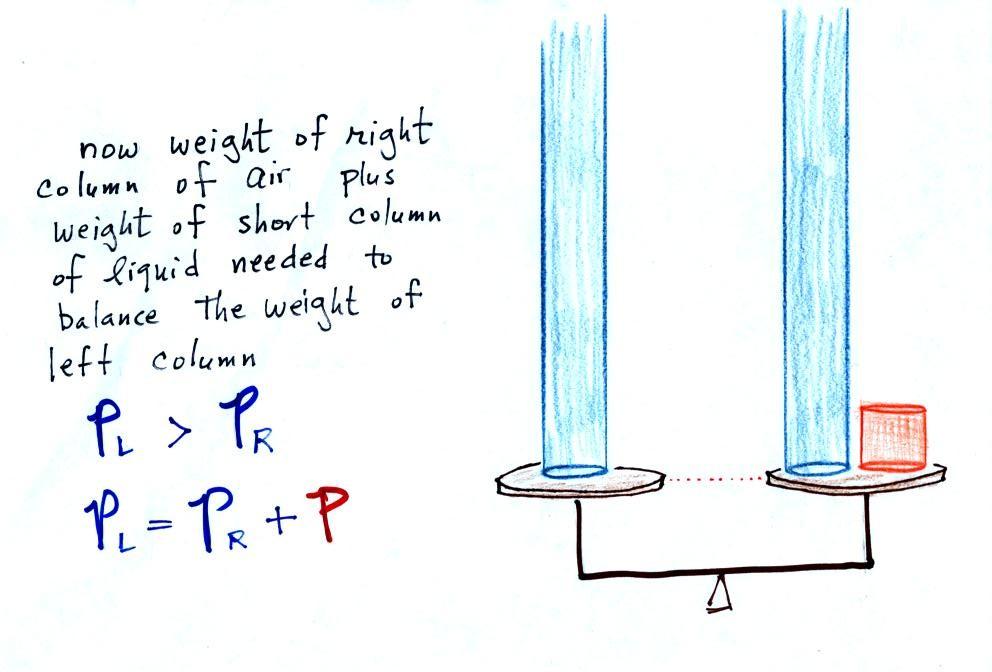
|
Now
the
situation is a little
different,
the
liquid levels
are no
longer equal. You probably realize that the air pressure on the
left, PL, is a little higher than
the air pressure on the
right,
PR. PL is now being balanced by PR
+ P acting together. P
is the pressure produced by the weight of the extra fluid on the right
hand side of
the manometer (the fluid that lies above the dotted line). The
height
of
the
column
of
extra
liquid
provides
a
measure
of
the
difference
between
PL and PR.
Next we will just go and close off
the right hand side of the
manometer.

|
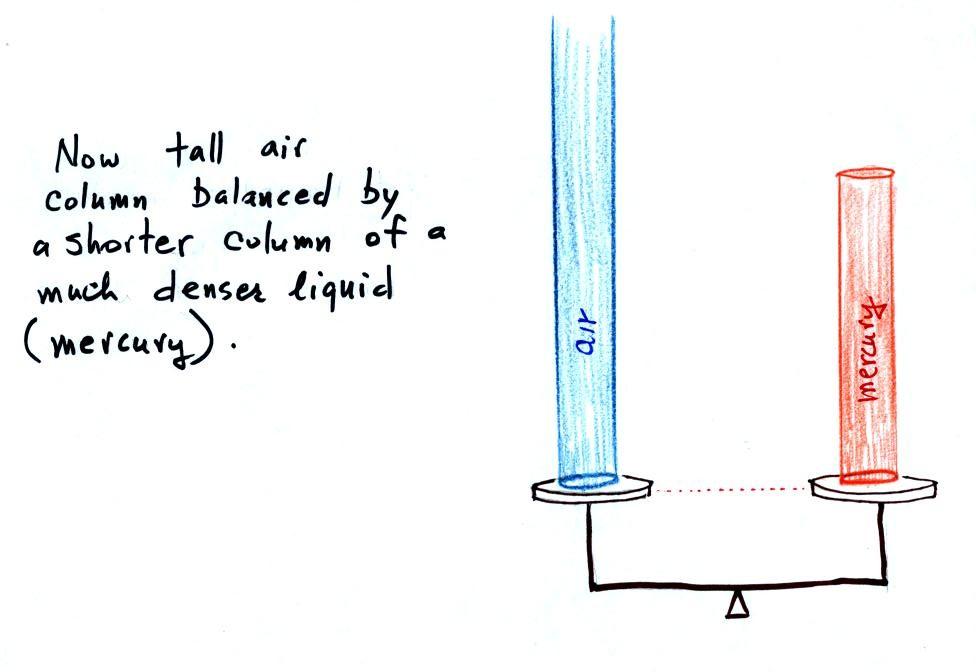
|
Air pressure can't get into the
right tube any
more. Now at the level of the dotted line the balance is between
Pair and P (pressure by the extra
liquid on the
right). If
Pair
changes, the height of the right column, h, will
change. You now have a barometer, an instrument that can measure
and monitor the atmospheric pressure.
Barometers like this are usually
filled with mercury. Mercury is
a liquid. You need a liquid that can slosh back and forth in
response to changes in air pressure. Mercury is also very dense
which
means the barometer won't need to be as tall as if you used something
like water. A water barometer would need to be over 30 feet
tall. With mercury you will need only a 30 inch tall column to
balance the weight of the atmosphere at sea level under normal
conditions (remember the 30 inches of mercury pressure units mentioned
earlier). Mercury also has a low rate of
evaporation so you don't have much mercury gas at the top of the right
tube (there's some gas, it doesn't produce much pressure, but it would
poison you if you were to start to breath it).

Here is a more conventional
barometer design.
The bowl of
mercury is usually covered in such a way that it can sense changes in
pressure but is sealed to keep poisonous mercury
vapor from filling a room.
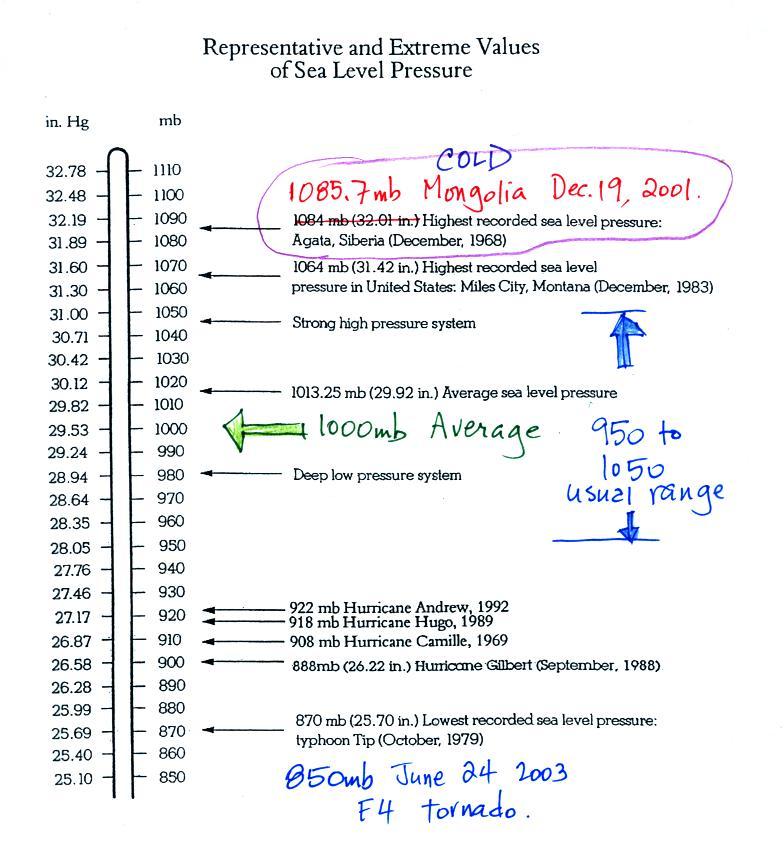
Average sea level atmospheric
pressure is about 1000 mb. The figure above (p. 30 in the
photocopied Class Notes)
gives 1013.25 mb but 1000 mb is close enough in this class. The
actual pressure can be higher or lower than this average value and
usually falls between 950 mb and 1050 mb.
The figure also includes record high and low pressure
values. Record high sea level
pressure values occur during cold weather. The TV
weather
forecast will often associate hot weather with high pressure.
They are generally referring to upper level high pressure (high
pressure at some level above the ground) rather than surface pressure.
Most of the record low pressure
values have all been set by intense hurricanes (the extreme low
pressure is the reason these storms are so intense). Hurricane
Wilma in 2005 set a new record low sea level pressure reading for the
Atlantic, 882 mb. Hurricane Katrina had a pressure of 902
mb.
The following table lists some of the information on hurricane strength
from p. 146a in the photocopied ClassNotes. 3 of the 10 strongest
N. Atlantic hurricanes occurred in 2005.
Most
Intense
North
Atlantic
Hurricanes
|
Most
Intense
Hurricanes
to
hit
the
US
Mainland
|
Wilma
(2005)
882
mb
Gilbert (1988) 888 mb
1935 Labor Day 892 mb
Rita (2005) 895 mb
Allen (1980) 899
Katrina (2005) 902
|
1935
Labor
Day
892
mb
Camille (1969) 909 mb
Katrina (2005) 920 mb
Andrew (1992) 922 mb
1886 Indianola (Tx) 925 mb |
Note that a new all time record low sea level pressure was
measured in 2003 inside a strong tornado in Manchester, South Dakota
(F4 refers to the Fujita scale rating, F5 is the highest level on the
scale). This is very difficult (and potentially dangerous thing)
to do. Not only must the instruments be built to survive a
tornado but they must also be placed on the ground ahead of an
approaching tornado and the tornado must then pass over the instruments.
What about
density. How does air density change with
increasing altitude? You get out of breathe more
easily at high altitude than at sea level. Air gets
thinner (less dense) at higher altitude.
Because air is compressible, a stack of mattresses might be a more
realistic representation of layers of air than a pile of bricks.
Four mattresses are stacked on top of each
other. Mattresses
are reasonably heavy, the mattress at the
bottom of the
pile is compressed by the weight of the three mattresses
above. This is shown at right. The mattresses higher up
aren't squished as much because
their
is less weight remaining above. The same is true with layers of
air in the atmosphere.
The statement above is at the top of p. 34 in the photocopied
ClassNotes. I've redrawn the figure found at the bottom of p. 34
below.
There's a lot of information in
this figure and it is worth
spending a minute or two looking at it and thinking about it.
1. You can first notice and remember that pressure
decreases
with increasing altitude. 1000 mb at the bottom decreases to 700
mb at the top of the picture. You should be able to explain why
this happens.
2. Each layer of air contain the same amount (mass) of
air.
This is a fairly subtle point. You can tell because the pressure
drops by 100 mb as you move upward through each layer.
Pressure depends on weight. So
if all the pressure changes are equal, the
weights of each of the layers must be the same. Each of the
layers
must contain the same amount (mass) of air (each layer contains
10% of the air in
the atmosphere).
3. The densest air is found at the bottom of the picture.
The bottom layer is compressed the most because it is
supporting the weight of all of the rest of the atmosphere. It is
the
thinnest layer in the picture and the layer with the smallest
volume. Since each
layer has the same amount of air
(same mass) and the bottom layer has
the
smallest volume it must have the highest density. The top layer
has the same amount of air
but about twice the volume. It therefore has a lower density
(half the density of the air at sea level). Density is decreasing
with increasing altitude.
4. Finally pressure is decreasing most rapidly with increasing
altitude in the densest air in the bottom layer. This is
something we covered on Wednesday.
Pressure
at
any
level in the
atmosphere depends on (is determined by) the weight of the air
overhead. You might get the idea that pressure just pushes
downward.
Air pressure is a force that pushes
downward, upward, and
sideways.
If you fill a balloon with air and then push downward on it, you can
feel the air in the balloon pushing back (pushing upward). You'd
see the air in the balloon pushing sideways as well.
Another helpful representation of air in the atmosphere might be a
people pyramid.
If the bottom person in the stack
above were standing on a
scale, the
scale would measure the total weight of all the people in the
pile. That's analogous to sea level pressure being determined by
the weight of the all the air above.
The bottom person in the
picture above must be strong enough to support the weight of all the
people above. That is equivalent to the bottom layer of the
atmosphere pushing upward with enough pressure to support the weight of
the air
above.
The air
pressure in the four tires on your automobile pushes
pushes upward
with enough force to keep this 1000 or 2000 pound vehicle (my own
personal vehicle) off the ground. The air pressure also pushes
downward, you'd feel it if the
car ran over your foot.
This was a logical point to do a
demonstration. A demo that
tries to prove that air pressure really does push upward as well as
downward. Not only that but that the upward force is fairly
strong. The demonstration is summarized on p. 35 a in the
ClassNotes.
Don't worry too much about the
details above because there's a more detailed explanation is
below. At this point you should wonder why is it that the water
in a balloon will fall while the water in the wine glass does not.
Here's a little bit more detailed
and more complete explanation of
what is going on. First the case of a water balloon.
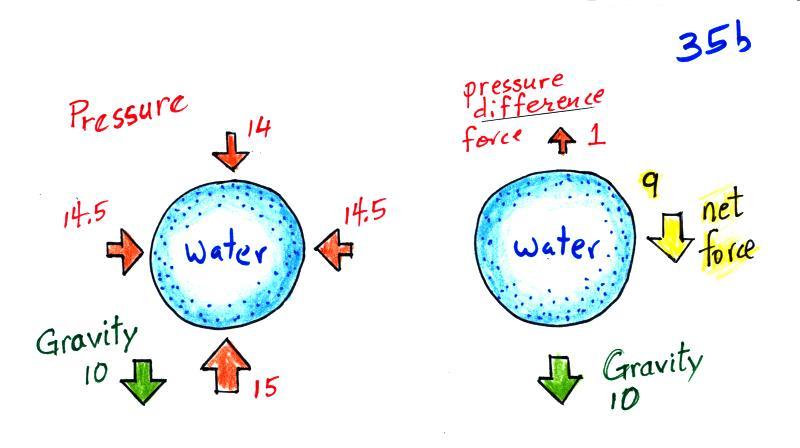
The figure at left shows air
pressure (red
arrows)
pushing on all
the
sides of the balloon. Because pressure decreases with increasing
altitude, the pressure from the air at the top of the balloon pushing
downward (strength=14) is a
little weaker than the pressure from the air at the bottom of the
balloon that is pushing upward (strength=15). The two sideways
forces cancel each other
out. The
total effect of the pressure is a weak upward pressure difference force
(1 unit of upward
force shown at the top of the right
figure).
Gravity exerts a downward force on the water
balloon. In the figure at right you can see that the gravity
force (strength=10) is stronger than the upward pressure difference
force (strength=1). The
balloon falls as a result. This is what you know would happen if
you let go of a water balloon, it would fall.
In the demonstration a wine glass is filled with water. A
small
plastic lid is used to cover the wine glass. The wine glass is
then turned upside and the water does not fall out.
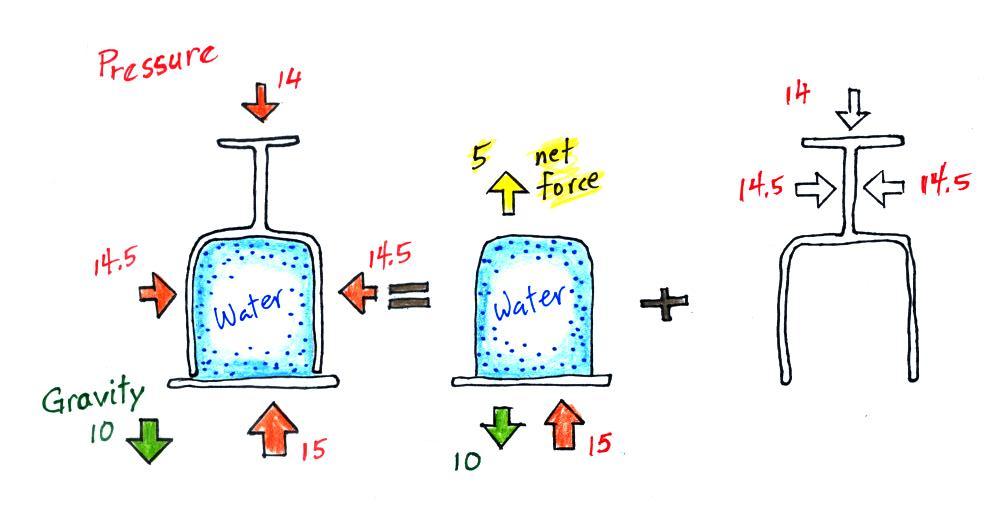
All the same forces are shown again
in the left most
figure. In
the right two figures we separate this into two parts. First
the water inside the glass isn't feeling the downward and sideways
pressure forces (because they're pushing on the glass, they're included
on the right figure ). Gravity
still pulls downward on the water but the upward pressure force is able
to overcome the downward pull of gravity. It can do this because
all 15 units are used to overcome gravity and not to cancel out the
downward pointing pressure force. The net upward force is strong
enough to keep the water in the glass.
The demonstration was repeated using a 4 Liter flash (more than a
gallon of water, more than 8 pounds of water). The upward
pressure force was still able to keep the water in the flask (much of
the weight of the water is pushing against the sides of the flask which
the instructor was supporting with his arms).
What
difference
does it make if pressure decreases with
increasing altitude or if pressure pushes upward, downward, and
sideways?
Here's one answer to that question.
Hot air balloons can go up and come back down. I'm pretty
sure you know what would cause the balloon to
sink. I suspect you don't know what causes it to float upward.
Gravity pulls downward on the
balloon. The strength of this force will depend on whether the
air is hot low density air (light weight) or cold higher density air
(heavier air).
Pressure from the air surrounding the balloon is pushing against
the top, bottom, and sides of the balloon (the blue arrows shown above
at right). Pressure decreases with increasing
altitude.
The pressure at the bottom pushing up is a little higher than at the
top pushing down (the pressures at the sides cancel each other
out). Decreasing pressure with increasing altitude creates an
upward pointing pressure difference force that opposes gravity.












